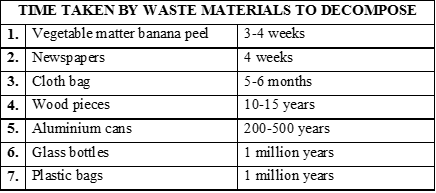- Books Name
- CBSE Class 6 Science Book
- Publication
- Param Publication
- Course
- CBSE Class 6
- Subject
- Science
Types of Waste on the Basis of Degradability
All wastes can be classified into two main groups on the basis of their ability to get decomposed. They are:
1. Biodegradable wastes
2. Non-biodegradable wastes
1. Biodegradable wastes
Biodegradable wastes are those which can be decomposed by the microorganisms into simpler substances. If properly handled, this type of waste causes no harm. A few examples of biodegradable wastes are peels and cuttings of fruits and vegetables, cow dung, plant residue and agricultural waste. This type of waste can be recycled by making vermicompost or for preparing biogas.
Vermicompost
The process of preparing compost with the help of red worms is called vermicomposting. The red worm is a type of earthworm that lives in the soil rich in organic matter, which is a combination of nitrogen-rich and carbon-rich material with plenty of moisture and microbes.
Method of Vermicompositing :
• A vermicomposting pit is made with a wooden box or big cement rings.
• A mesh is spread at the bottom of the pit.
• Vegetable waste, fruit waste, waste paper which is not shiny or coated with plastic, is spread over the mesh.
• Water is sprinkled to create moisture so that the redworms can live.
• A vermicomposting pit takes nearly two to four weeks to completely convert waste into manure.
• Waste material that is rich in oils, salt, meat and vinegar stops the growth of red worms.
• These red worms have a special structure called gizzards with which they grind food material. A red worm eats food equal to its weight every day. Red worms do not survive in too hot or too cold conditions.


 PathSet Publications
PathSet Publications
 Param Publication
Param Publication
